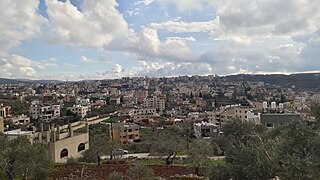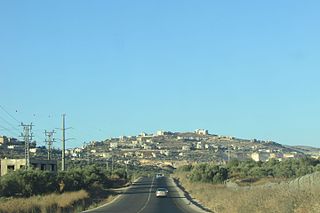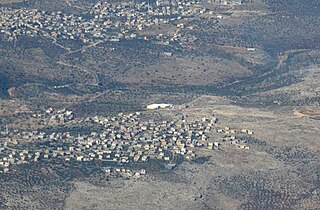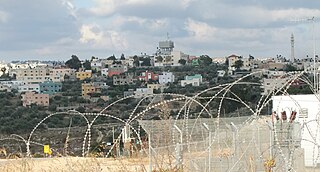
Salfit is a Palestinian city in the central West Bank, and the capital of the Salfit Governorate of the State of Palestine. Salfit is located at an altitude of 570 meters (1,870 ft), adjacent to the Israeli settlement of Ariel. According to the Palestinian Central Bureau of Statistics (PCBS), Salfit had a population of 10,911 in 2017. Since the 1995 Interim Agreement on the West Bank and the Gaza Strip, Salfit, located in Area A, has been administered by the Palestinian National Authority, while continuing under Israeli military occupation.

Kifl Haris is a Palestinian village in the northern West Bank, located six kilometers west of Salfit and 18 kilometers south of Nablus, in the Salfit Governorate of the State of Palestine; it is located northwest of the Israeli settlement of Ariel.

Deir Ballut is a Palestinian town in the Salfit Governorate in the northern West Bank, 41 kilometers (25 mi) south west of Nablus. According to the Palestinian Central Bureau of Statistics, it had a population of 3,873 in 2017.

Jamma'in is a Palestinian town in the Nablus Governorate of the State of Palestine, in the northern West Bank, located 16 kilometers (9.9 mi) southwest of Nablus, 6 kilometers (3.7 mi) northwest of Salfit and 40 kilometers (25 mi) north of Ramallah. According to the Palestinian Central Bureau of Statistics, the town had a population of 7,436 in 2017.

Kafr ad-Dik is a Palestinian town located 9.5 kilometers west of Salfit in the Salfit Governorate of Palestine, in the northern West Bank. According to the Palestinian Central Bureau of Statistics (PCBS), the town had a population of 5,551 in 2017.

Bruqin is a Palestinian town 13 kilometers west of Salfit in the Salfit Governorate of the State of Palestine, in the northern West Bank, adjacent to the Israeli settlement of Brukhin, which was built over lands confiscated from the Palestinian town. According to the Palestinian Central Bureau of Statistics, Bruqin had a population of 4,047 in 2017. The town used to be on a camel-trading route. There is evidence of Roman rule in the city due to the presence of three ancient pools and a tomb.

Qarawat Bani Hassan is a Palestinian town in the Salfit Governorate of the state of Palestine, 30 kilometers southwest of Nablus and 8 kilometers northwest of Salfit in the northern West Bank. According to the Palestinian Central Bureau of Statistics, the town had a population of 5,513 in 2017.

Biddya is a Palestinian city in the Salfit Governorate, located 32 kilometers southwest of Nablus and half that distance from Salfit in the northern West Bank. According to the Palestinian Central Bureau of Statistics (PCBS), Biddya had a population of 10,451 in 2017. The town is governed by a municipal council of eleven members who each represent the prominent families of Biddya and select a mayor.

Az-Zawiya is a Palestinian town in the Salfit Governorate of the State of Palestine, in the northern West Bank, located west of Salfit and south of Qalqilya. According to the Palestinian Central Bureau of Statistics, az-Zawiya had a population of 6,033 in 2017. The town's population is made up of primarily three families: Shuqeir (45%), Muqadi (30%) and Raddad (20%), while the remaining 5% consists of Palestinian refugee families such as Shamlawi, Rabi and Yusif.

Einabus is a Palestinian village in the northern West Bank, located 12 kilometers south of Nablus and a part of the Nablus Governorate. Nearby towns include Huwara and Beita to the east and Jammain to the south.

Salim is a Palestinian town in the northern West Bank, located six kilometers east of Nablus and is a part of the Nablus Governorate. According to the Palestinian Central Bureau of Statistics (PCBS), Salim had a population of 6,266 inhabitants in 2017.
Farkha is a Palestinian village in the Salfit Governorate in the northern West Bank, 30 kilometers south of Nablus. According to the Palestinian Central Bureau of Statistics, it had a population of 1,650 in 2017.

Haris is a Palestinian town in the Salfit Governorate of the State of Palestine, in the northern West Bank, 24 kilometers Southwest of Nablus. According to the Palestinian Central Bureau of Statistics, it had a population of 4,137 in 2017.

Marda is a Palestinian town in the Salfit Governorate of the State of Palestine, in the northern West Bank, 18 kilometers southwest of Nablus. According to the Palestinian Central Bureau of Statistics, it had a population of 2,375 in 2017.

Iskaka is a Palestinian town in the Salfit Governorate of the State of Palestine, in the northern West Bank, 27 kilometers southwest of Nablus. According to the Palestinian Central Bureau of Statistics, it had a population of 1,198 in 2017.

Qira is a Palestinian town in the Salfit Governorate in the northern West Bank, 19 kilometers southwest of Nablus. According to the Palestinian Central Bureau of Statistics, it had a population of approximately 1,278 in 2017.

Sarta is a Palestinian town in the Salfit Governorate in the northern West Bank, 22 kilometers southwest of Nablus. According to the Palestinian Central Bureau of Statistics, it had a population of approximately 3,382 in 2017.

Mas-ha is a Palestinian village in the Salfit Governorate in the northern West Bank, 24 kilometers southwest of Nablus. According to the Palestinian Central Bureau of Statistics, it had a population of 2,370 in 2017.

Burin is a Palestinian village in the Nablus Governorate of the State of Palestine, in the northern West Bank, located 7 kilometres (4.3 mi) southwest of Nablus. The town had a population of 2,844 in 2017.

As-Sawiya is a Palestinian town in the Nablus Governorate of the State of Palestine, in the northern West Bank, located 18 kilometers south of Nablus. According to the Palestinian Central Bureau of Statistics (PCBS), the town had a population of 2,761 inhabitants in 2017.






















